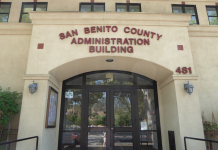By Emily Alpert Staff Writer
Gilroy
– The thunk-thunk of low-flying helicopter rotors jostled
Roberta Carreiro out of a sound sleep in Sunday’s wee hours.
Gilroy – The thunk-thunk of low-flying helicopter rotors jostled Roberta Carreiro out of a sound sleep in Sunday’s wee hours. Below her tidy, ranch-style home, Highway 152 wound its way toward a grisly crash, miles down the road where three people – two elderly women and a 2-year-old boy – lay dead, partially ejected from their minivan. None were wearing seatbelts.
It was, she said, a sadly familiar sound.
Since she moved here less than a year ago, Carreiro has woken several times to blaring sirens and hovering choppers plucking victims from the road’s treacherous curves. Santa Clara County Supervisor Don Gage calls it a death trap, a serpentine two-lane highway that links Gilroy to Los Banos and beyond. Two months ago, a big-rig collision halted traffic on the artery for more than 30 hours. In December of 2005 an SUV and a delivery truck collided head-on, killing four members of a family.
Sunday, a minivan packed with eight passengers, some buckled, some not, veered across the rain-soaked road and flipped into a ditch east of Lovers Lane. Consuelo Manzo, 66, and 2-year-old John Venegas, both of Palo Alto, and 75-year-old Carmen Garcia Valencia, of Michoacan, Mexico, died at the scene. None wore seat belts. The driver, 24-year-old Juan Manzo, suffered minor injuries. He was the only victim who was buckled in when the car skidded off the road and overturned shortly after 2am. The relationship between the eight was unavailable at press time. The accident is under investigation.
The deaths have reignited a long-running debate over Highway 152, but the California Highway Patrol said molasses-slow traffic has diminished the danger on the state highway. This year, 98 accidents have occurred on the highway, two of them fatal, according to Officer Chris Armstrong, CHP spokesman. Those numbers aren’t unusual, he said.
“In the past, it was one of the most dangerous roadways in California,” said Armstrong, “but currently, it’s no more dangerous than any other roadway, because the flow of traffic has slowed down.”
On weekends and holidays, cars line the highway like beads, trapping Pacheco Pass residents like Carreiro in their homes, and extending the time to travel the 13 miles by hours. But Pat Midtgaard, who’s lived on Pacheco Pass Highway for 36 years, can’t be convinced that gridlock has halted the danger.
“I’ve seen too many accidents to count,” she said. “It’s a two-lane country road, and it was never intended to carry the amount of traffic it is now.”
To ease the burden placed on the narrow highway, Caltrans is building an overpass near the Highway 152/Highway 156 split. The overpass should help unclog the afternoon commute, said Armstrong. But the fix won’t uncurl the hazardous highway, Gage and Midtgaard agreed.
“It’s a Band-Aid,” complained Midtgaard. “It’s too little, too late.”
Gage said he’s advancing plans with San Benito County officials for an additional four-lane highway to supplement the two-lane stretch between Casa de Fruta and Gilroy. Widening Pacheco Pass would cost too much, he said, and those curves can’t be ironed straight.
On both sides of the San Benito/Santa Clara county line, officials have agreed to prioritize the road. Bob Davies, executive director of the San Benito County Council of Governments, Gilroy Mayor Al Pinheiro, Gage and other officials are positioning South County for funds from Proposition 1B, an infrastructure bond approved last month. Untangling Highway 152 tops their wish list, Davies has said.
For Midtgaard, it’s about time.
“I’ve gone to so many meetings. We’re at the very, very end of Santa Clara County, and we always seem to be at the tail end. It never seems to be a priority,” she said. “But drive out here on any holiday, and tell me it’s not a priority.”
Emily Alpert covers public safety issues for The Dispatch. She can be reached at 847-7158, or at ea*****@************ch.com.








